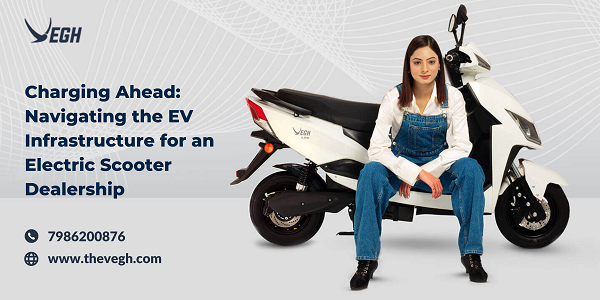
The electric scooter market has witnessed a surge in demand, driven by the global push towards sustainable and eco-friendly transportation solutions. As more consumers embrace electric scooters as a viable mode of urban commuting, the need for a robust electric vehicle (EV) charging infrastructure becomes increasingly crucial. For electric scooter dealerships, ensuring a reliable and accessible EV charging network is paramount in providing a seamless ownership experience to customers. In this blog, we will explore the significance of EV infrastructure for scooter dealerships and highlight strategies to navigate the charging landscape successfully.
EV charging infrastructure serves as the backbone of the electric mobility ecosystem. It provides essential support to electric scooter owners by offering a convenient and efficient way to recharge their vehicles. For an electric scooter dealership, an accessible charging network is an attractive feature that enhances the overall ownership experience for customers and helps to position the dealership as a forward-thinking and customer-centric entity.
An Electric scooter dealership should familiarize themselves with the different types of charging options available to their customers:
a) Level 1 Charging: Level 1 charging refers to charging using a standard household outlet. While it is the slowest charging option, it is widely accessible and requires no special charging equipment.
b) Level 2 Charging: Level 2 charging stations use higher voltage (240 volts) and provide faster charging speeds compared to Level 1. These stations are commonly found in public spaces, workplaces, and commercial areas.
c) DC Fast Charging: DC fast chargers deliver high-voltage direct current, enabling rapid charging in a short period. These chargers are typically located along major highways and key urban hubs, offering a quick top-up for long-distance journeys.
To provide a superior customer experience, an electric scooter dealership can consider establishing in-dealership charging facilities. Installing Level 2 chargers in the dealership’s premises not only showcases the dealership’s commitment to electric mobility but also offers a convenient charging option for customers during their visits. In-dealership charging facilities can serve as a powerful marketing tool, attracting potential customers who may not have considered an electric scooter due to charging concerns.
Partnering with established charging network providers can be an effective strategy for an electric scooter dealership to ensure a wide and accessible charging network for their customers. Collaborating with reputable providers gives customers access to a growing network of public charging stations, bolstering confidence in the feasibility of owning an electric scooter. This collaboration can be mutually beneficial, as it attracts more potential customers to the charging network provider while increasing foot traffic to the dealership.
As part of a customer-centric approach, an electric scooter dealership should proactively educate their customers about charging solutions and options available to them. This includes guiding customers on how to locate nearby charging stations, understanding charging times, and the benefits of using different types of chargers. By providing this information, dealerships empower their customers to make informed decisions about charging their electric scooters.
In the digital age, mobile apps and digital platforms play a crucial role in facilitating a seamless charging experience for electric scooter owners. Encouraging customers to download relevant charging apps and use online platforms that provide real-time information about nearby charging stations enhances convenience and accessibility. Many charging apps also offer features such as reservation options and payment processing, making the charging process even more user-friendly.
As the focus on sustainability grows, electric scooter dealerships can explore integrating their charging infrastructure with renewable energy sources. Installing solar panels or wind turbines to power the charging stations not only reduces the carbon footprint of the dealership but also aligns with the eco-friendly values of electric mobility. Offering clean energy charging options can be an appealing factor for environmentally conscious customers.
Many businesses and delivery services are turning to Electric Scooters for their fleet operations. For electric scooter dealerships, this presents an opportunity to offer customized charging solutions for fleet owners. Providing bulk charging options, setting up dedicated charging hubs, and offering flexible payment plans for fleet charging can attract commercial clients and foster long-term business partnerships.
Range anxiety, the fear of running out of battery power during a journey, is a common concern among electric scooter owners. To address this issue, scooter dealerships can provide range optimization tips, recommend strategic charging locations, and promote the benefits of battery management for extended journeys. Addressing range anxiety proactively helps to build trust and confidence in electric scooter ownership.
In the rapidly growing Electric Scooter market, a robust EV charging infrastructure is essential for electric scooter dealerships to thrive and provide exceptional service to their customers. Understanding different charging options, establishing in-dealership charging facilities, collaborating with charging network providers, educating customers about charging solutions, embracing digital platforms, integrating with renewable energy sources, catering to fleet owners, and addressing range anxiety are all key strategies to navigate the EV infrastructure successfully. By adopting a customer-centric approach and investing in a reliable charging network, an electric scooter dealership can contribute significantly to the sustainable and eco-friendly future of urban transportation. A well-planned and accessible charging infrastructure not only attracts more customers to the dealership but also fosters brand loyalty, driving the electric scooter market forward with a charging-ahead mentality.